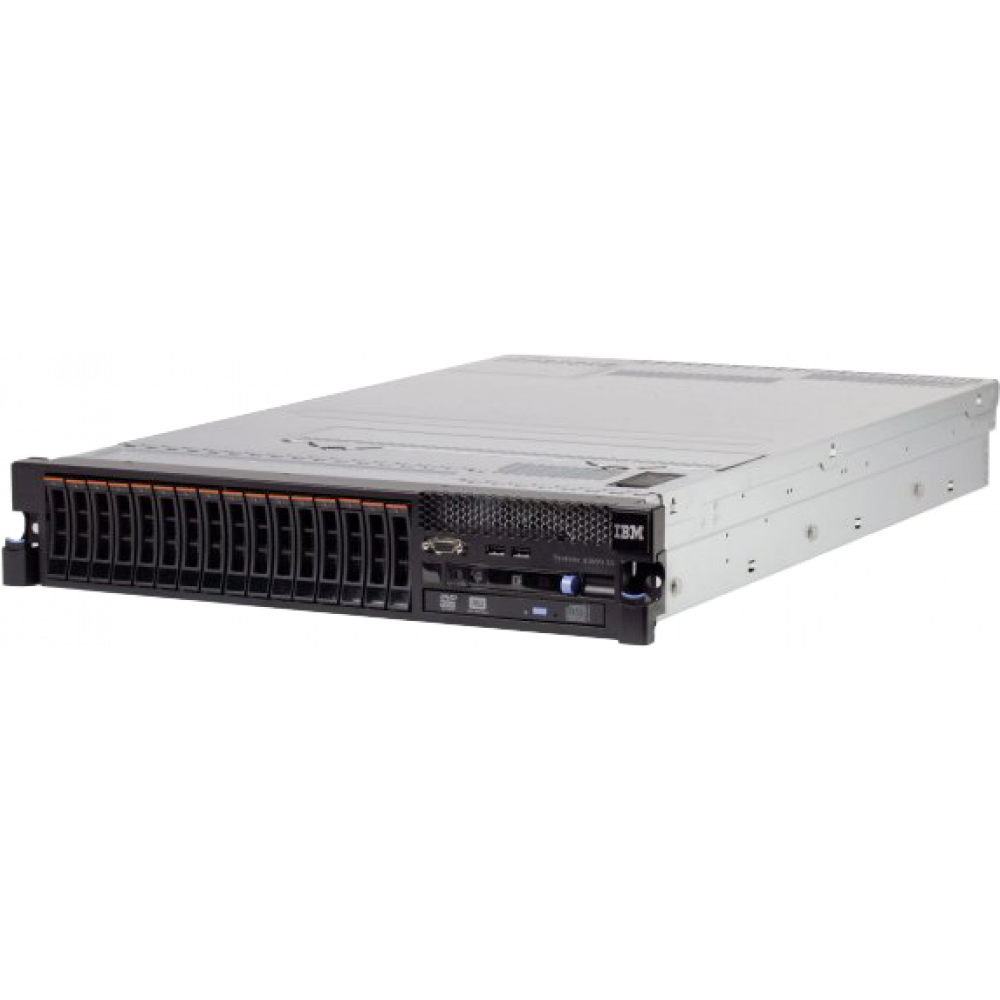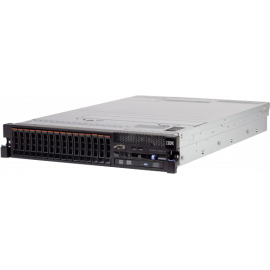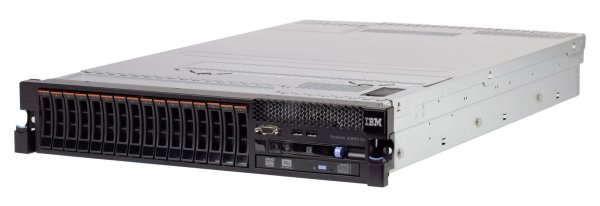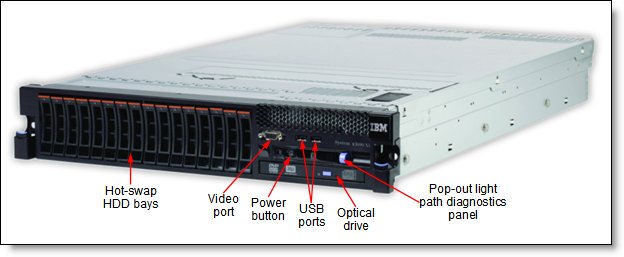The x3690 X5 is an outstanding 2U two-socket
mission-critical server, offering outstanding performance, superior
reliability, and fault-tolerant memory characteristics.
Lenovo has been designing and implementing servers under the
X-Architecture® name since 2001. eX5 technology represents the fifth
generation of enterprise servers based on the same design principle
Lenovo began with in 1997: to offer systems that are expandable, offer
“big iron” reliability, availability, and serviceability (RAS) features,
with extremely competitive price/performance on an Intel Xeon
processor-based system.
Scalability and performance
The x3690 X5 offers numerous features to boost performance, improve scalability, and reduce costs:
- The x3690 X5 supports up to two high-performance Intel Xeon E7 family allowing you to upgrade as business needs require.
- Supports the Intel Xeon E7-2800, E7-4800 and E7-8800 families of
high performance processors, up to 10 cores each, offering superior
system performance
- Intel Turbo Boost Technology dynamically turns off unused processor
cores and increases the clock speed of the cores in use, by up to three
model frequencies. For example, with 7-10 cores active, a 2.4 GHz
E7-2870 10-core processor can run the cores at up to 2.53 GHz. With 5-6
cores active, it can run those cores at 2.67 GHz; with only 1-4 cores
active, it can run those cores at 2.8 GHz
- Each processor includes two integrated memory controllers, to
reduce memory bottlenecks and improve performance. Memory access is at
up to 1066 MHz frequency, depending on the processor model and memory
used.
- The MAX5 V2 adds an additional four memory controllers for a total
of eight memory controllers to maximize memory parallelism and
performance.
- In processors implementing Hyper-Threading technology, each core
has two threads capable of running an independent process. Thus, an
8-core processor can run 16 threads concurrently.
- Intel’s Virtualization Technology (VT) integrates hardware-level
virtualization hooks that allow operating system vendors to better
utilize the hardware for virtualization workloads.
- Intel QuickPath Interconnect (QPI) technology for
processor-to-processor connectivity and Intel Scalable Memory
Interconnect (SMI) processor-to-memory connectivity:
- Intel QPI link topology at up to 6.4 Gbps with four QPI links per CPU
- Intel SMI link topology at up to 6.4 Gbps with four SMI links per CPU
- Up to 32 dual inline memory modules (DIMMs) in the base system (16
on the system planar and 16 on an optional memory mezzanine inside the
server), plus an additional 32 DIMMs with an optional 1U MAX5 V2 memory
expansion unit, for a total of 64 DIMM sockets.
- Support for 32 GB DIMMs for a maximum of 2 TB per x3690 X5 with MAX5 V2
- The use of solid-state drives (SSDs) instead of, or along with,
traditional spinning drives (HDDs) can significantly improve I/O
performance. An SSD can support up to 100 times more I/O operations per
second (IOPS) than a typical HDD.
- Up to 24 1.8-inch SSD bays, or up to 16 2.5-inch bays together with
the option of an optical drive, provide a flexible and scalable
all-in-one platform to meet your increasing demands.
Availability and serviceability
The x3690 X5 provides many features to simplify serviceability and increase system uptime:
- Support for machine check architecture (MCA) recovery, a feature
of the Intel Xeon processor E7 family, which enables the handling of
system errors that otherwise require the operating system to be halted.
SAP HANA is one of the first application which leverages the MCA
recovery to handle system errors in order to prevent the application
from being terminated in case of a system error.
- Extensive memory protection with Chipkill, and, with DIMMs
containing x4 DRAM modules, Redundant Bit Steering (RBS) (also known as
Double Device Data Correction or DDDC) is also supported . The
combination of Chipkill and RBS provides very robust memory protection
that sustains to two sequential memory DRAM chip failures without
affecting overall system performance.
- Redundant CPU-to-I/O hub interconnect links provide ability to
self-recover from CPU failure. If primary CPU fails then eX5 systems can
use the second CPU to boot the OS as they still have access to the
integrated I/O devices because of redundant links between CPUs and I/O
hubs.
- Memory mirroring and memory rank sparing for redundancy in the event of a non-correctable memory failure.
- Hot-swap drives, supporting RAID redundancy for data protection and greater system uptime.
- Four redundant hot-swap power supplies and five redundant hot-swap
fans to provide availability for business-critical applications.
- The power source independent light path diagnostics panel and
individual light path LEDs quickly lead the technician to failed (or
failing) components, which simplifies servicing, speeds up problem
resolution, and helps improve system availability.
- Predictive Failure Analysis (PFA) detects when system components
(processors, VRMs, memory, HDDs, fans, and power supplies) operate
outside of standard thresholds and generates proactive alerts in advance
of a possible failure, therefore increasing uptime.
- Solid-state drives (SSDs) offer significantly better reliability than traditional mechanical HDDs for greater uptime.
- Built-in Integrated Management Module Version II (IMM2)
continuously monitors system parameters, triggers alerts, and performs
recovering actions in case of failures to minimize downtime.
- Built-in diagnostics, using Dynamic Systems Analysis (DSA) Preboot, speed up troubleshooting tasks to reduce service time.
- Three-year customer-replaceable unit and on-site limited warranty,
9x5 next business day. Optional service upgrades are available.
Manageability and security
Powerful systems management features simplify local and remote management of the x3690 X5:
- The server includes an Integrated Management Module (IMM) to monitor server availability and perform remote management.
- Integrated industry-standard Unified Extensible Firmware Interface
(UEFI) enables improved setup, configuration, and updates, and
simplifies error handling.
- Integrated Trusted Platform Module (TPM) 1.2 support enables
advanced cryptographic functionality, such as digital signatures and
remote attestation.
- IBM Systems Director is included for proactive systems management.
It offers comprehensive systems management tools that help to increase
uptime, reduce costs, and improve productivity through advanced server
management capabilities.
Energy efficiency
The x3690 X5 offers the following energy-efficiency features to save
energy, reduce operational costs, increase energy availability, and
contribute to the green environment:
- Energy-efficient planar components help lower operational costs.
- Support for one, two or four highly efficient 675 W ac power
supplies allows for efficient use and scalability to meet the power
requirements of the installed components.
- Intel Xeon processor E7-2800/4800/880 product family offers
significantly better performance over the previous generation while
fitting into the same thermal design power (TDP) limits.
- Low-voltage Intel Xeon processors draw less energy to satisfy the
demands of power and thermally constrained data centers and
telecommunication environments.
- Low-voltage 1.35 V DDR3 memory RDIMMs consume 15% less energy compared to 1.5 V DDR3 RDIMMs.
- Solid state drives (SSDs) consume as much as 80% less power than traditional spinning 2.5-inch HDDs.
- The server uses hexagonal ventilation holes, which is a part of
Calibrated Vectored Cooling technology. Hexagonal holes can be grouped
more densely than round holes, providing more efficient airflow through
the system.
- IBM Systems Director Active Energy Manager™ provides advanced data
center power notification and management to help achieve lower heat
output and reduced cooling needs.








